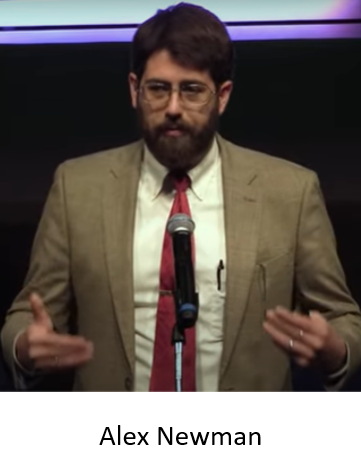Community Schools: Orwellian Takeover of Education
“It’s criminal activity hiding in plain sight,” says journalist, speaker, educator, author, and consultant Alex Newman in his new presentation on the state of public education in America. “Your kids are dumb as a box of rocks,” he contends, “not according to Alex Newman, but according to the U.S. government itself.” Newman is referring to the dismal results of the National Assessment of Educational Progress (NAEP), the most recent findings of which Education Reporter described in its July issue. Newman adds: “What they [NAEP researchers] have found is that less than one-third of the victims in public schools are proficient in anything,” meaning any core academic subject.
In 2015, Newman wrote an article in The New American magazine describing an Obama Administration plot “to unconstitutionally commandeer local schools and turn them into full-service community schools — government centers that will usurp vast new responsibilities over children that have traditionally been handled by parents and families.”
 What are community schools? According to policies being implemented under the Full-Service Community Schools Program, these are “government-run elementary or secondary schools that participate in a community-based effort to coordinate and integrate educational, developmental, family, health, and other comprehensive services through community-based organizations and public and private partnerships.”
What are community schools? According to policies being implemented under the Full-Service Community Schools Program, these are “government-run elementary or secondary schools that participate in a community-based effort to coordinate and integrate educational, developmental, family, health, and other comprehensive services through community-based organizations and public and private partnerships.”
This Orwellian concept authorizes schools to provide “services” both before and after school, on the weekends, and during summer vacation. Included are “home visitation services by teachers and nurses; early childhood education; primary health and dental care; mental health counseling services; nutrition services; remedial education activities, enrichment activities,” and more.
The Institute for Educational Leadership website (IEL) indicates that many states “are looking to expand full-service community schools in 2023, with 17 states and Washington, DC having introduced 45 bills in support of such expansion.” In Maryland, for example, 8 bills are under consideration “that seek to allocate $100,000 for technical assistance, fund additional professional development opportunities for Community Schools, teachers, and staff, and provide clarity within current statutes to allow Full-Service Community Schools to access more funding streams and additional personnel resources, such as school counselors.” Minnesota has five bills pending that request “a total of $104 million to fund the planning and implementation of Community Schools across the state,” while Oklahoma is working on a pilot program.
In New York, five such bills have already passed. Resolution 555 provides “$450,000 in funding to United Community Schools and adds $105 million to the state funding formula for community schools.” IEL and the Coalition for Community Schools have expressed excitement for “the work being done on the local and state level to advocate for the advancement of the Full-Service Community Schools strategy and look forward to seeing what the rest of 2023 has in store for the Community Schools movement!”
The community schools scheme is not new; it embodies the “cradle-to-grave” education system Phyllis Schlafly warned about as far back as 1995. What’s new is the accelerated effort to substantially increase the current nationwide total of approximately 8,000 community schools in the wake of the COVID-19 pandemic “as a preferred reform strategy.” And if any further evidence is needed that Alex Newman may be on to something when he says community schools aim to replace parents, one of the concept’s strongest supporters is the National Education Association (NEA), which for decades has opposed the right of parents to oversee the upbringing and education of their children.
Brookings Institute report
In March 2022, The Learning Policy Institute, the Center for Universal Education at the Brookings Institute, a left-leaning think tank employing a staff that reportedly supports Democrat candidates 90 percent of the time, published a policy memo for the U.S. Department of Education pushing for more community schools, using the familiar excuse of COVID-19’s negative effect on education. The Brookings memo argues that the federal government should “turn to community schools as a response to the U.S.’s persistent failure to provide for the well-being of the most vulnerable children and families—a reality exacerbated [by the pandemic].”
The memo advocates for community schools, “not as a substitute for other much-needed policy changes in support of children and families, but as a way to employ a long-standing whole-child approach to schooling that coheres with a growing body of research about how all children learn.... Educators, children- and family-serving partners, and decisionmakers across the country are looking to long-standing community school strategies as a promising approach to mitigate the social and learning impacts of COVID-19.”
But no grandiose plan for more government control over the education system is complete without cries for “expanded funding,” and the Brookings memo calls for just that. While acknowledging that states have had access to Coronavirus aid through various federal acts passed between 2020 and 2021, the memo adds that “the $75 million investment in the Full-Service Community School Expansion Act Grant Program for FY 2022 [is] the most explicit investment in community school strategies in the history of the grant program.” At the same time, the memo notes that in 2022 “California invested $3 billion specifically in the California Community School Partnership Program (CCSPP) with the goal of ensuring that all of the state’s Title I schools operate as community schools.” Thus, funding for community schools involves federal, state, and local tax dollars.
The Brookings memo argues for a “consensus vision” for community schools that covers the gamut “of children’s development across multiple domains— including academic, physical, psychological, cognitive, social, and emotional learning....” It acknowledges that “[t]he community schools’ strategy is grounded in an ecosystem approach, meaning the goal is to improve the interrelated web of a child’s life at each level: individual, family, school, community, and society....”
Much of the Brookings document is couched in upbeat language emphasizing that community schools are “locally grown through a democratic co-creation and co-design process that is grounded in trusting, collaborative relationships among students, educators, families, community leaders, and other community-based partners.” But it also acknowledges that “students are enabled to understand their own rights and responsibilities in school, their community, and in society, and feel empowered to act as agents in their own and community wellbeing.” As Alex Newman predicted in 2015: “In other words, these ‘schools’ will expand and accelerate the ongoing usurpation of the role of families and parents in raising the next generation of Americans.”
Community schools are also about data collection, which has been part and parcel of education in varying degrees for decades. Among the data collection principles included in the Brookings memo are the following:
- Community schools are “data sources”... “from different levels of stakeholders involved in community schools, including students, parents, teachers, leaders, coordinators, and partners. Data collected and assessed must reflect all of these voices.”
- “Whole child metrics of student success,” which means not only measuring academic performance, but also the subjective “21st century cognitive and metacognitive skills, mindsets, and habits....” [Emphasis added.]
- “Multi-level wellbeing,” which refers to tracking and assessing “student behavior, trusting relationships, socioemotional learning, and a positive school climate and culture.”
Number 5 on the list refers to the collection of both quantitative and qualitative data. “Community schools are relationship-centered and data collection should reflect this,” the memo states. “Administrative data and descriptive statistics can only be one piece of a multifaceted evaluation, as perceptions, attitudes, engagement, and collaboration best captured in surveys, focus groups, interviews, and observations are key to understanding the impact of the community schools strategy.”
The memo further admits: “Additionally, it is important to frame community schools as a comprehensive school transformation strategy.” [Emphasis added.]
A Philadelphia story
 A Facebook source had this to say about the community schools’ model as it is being implemented in Philadelphia, Pennsylvania: “It’s dangerous, and [the city of] Philadelphia is pushing it. When it comes to education, they prey and experiment on lower income [children and families] before they spread it to the rest of the nation.”
A Facebook source had this to say about the community schools’ model as it is being implemented in Philadelphia, Pennsylvania: “It’s dangerous, and [the city of] Philadelphia is pushing it. When it comes to education, they prey and experiment on lower income [children and families] before they spread it to the rest of the nation.”
Philadelphia’s community schools are a partnership between the city, the Philadelphia School District, and “school communities to remove barriers to learning and support the success of each student.” The city’s website uses a lot of upbeat, flowery descriptions of what the schools accomplish through grants for projects such as “Out-of-School Time activities, family and community engagement opportunities, and safe zone projects.” One such project involves students working at a community farm to help feed local needy families; a noble activity in and of itself, but some parents worry that these activities replace actual academic learning.
The website further describes the Philadelphia model:
- At its very core, the Community Schools model embodies the old phrase “It takes a village to raise a child.” And not only is this village big, it is constantly growing. This year, Community Schools engaged in over 700 partnerships to provide resources to students. Among these partnerships, there were over 300 programmatic partnerships and over 280 resource partnerships.
School-based health centers
The Ohio-based online newspaper Lobbyists for Citizens cautions that “public schools are becoming community centers.” Writer Brian Massie noted on July 31, 2023 that “the role of the public schools is morphing into a community center that will ultimately control the lives, bodies, and minds of our children.”
Massie was specifically referring to the 2022 announcement by Ohio Governor Mike DeWine about the allocation of $25.9 million in taxpayer funds “for 136 new or expanded School-Based Health Centers” throughout the state. The purpose? To “provide primary care services and preventative care in the school setting.” Some of these clinics provide dental, vision, behavioral health services, and more.
The official excuse for this government overreach is that such health initiatives “help ensure students are in school, healthy, and ready to learn through a school or district’s partnerships with health care providers and other community organizations.” It’s also a clear vindication of the Philadelphia Facebook mom’s concern that the rights of lower-income parents are the first to be usurped, with all others set to follow.
But as Brian Massie wrote: “Academic proficiency continues to drop in public schools while they ensure that the children can select which pronoun and bathroom they want to use, what sex they want to be, and which sports [teams] they want to play on. History is being modified, while the ‘love conquers all’ mantra is used to groom them for the LGBTQ+ lifestyle and the pedophile miscreants so prevalent in our sick society.”
Alex Newman is more direct: “Get your children out of public schools now!” he says, “then run for school board.” He adds: “They don’t care about your guns, they have your children. It’s not going to make any difference how many AR15’s or ammo you have stockpiled. When your kids show up on your front porch to confiscate them, you will do nothing.”
Such a scenario is a frightening prospect, but potentially not as far-fetched as the average American may once have imagined.
Want to be notified of new
Education Reporter content?
Your information will NOT be sold or shared and will ONLY be used to notify you of new content.
Click Here
Return to Home Page
